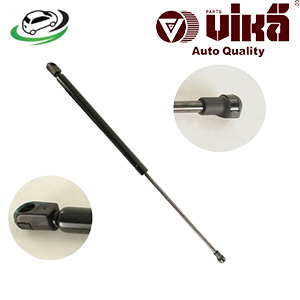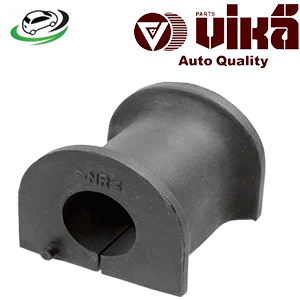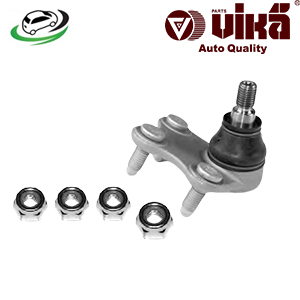-9%
Get Left Lower Ball Joint VW Polo GTI 1.40L/ Polo IV 1.20L/1.40L/ Polo V/ Vento 1.60L/ Voyage 1.60L/ AUDI A1 1.40L 6R0407365
A ball joint is a crucial component in a vehicle’s suspension and steering systems. It serves as a pivot point, allowing for smooth movement and flexibility in the suspension while also enabling the wheels to turn in response to steering input. Understanding the function, types, maintenance, and signs of wear of ball joints is essential for ensuring vehicle safety and performance. In this comprehensive guide, we will explore these aspects in detail, providing a thorough understanding of ball joints and their role in automotive systems.
What is a Ball Joint?
A ball joint is a spherical bearing that connects the control arms of a vehicle’s suspension to the steering knuckles. It functions similarly to the ball-and-socket joint in the human body, such as the hip joint, allowing for a wide range of movement. This flexibility is crucial for maintaining proper alignment and handling characteristics, especially as the suspension moves over bumps or uneven terrain.
Components of a Ball Joint
- Ball Stud: The ball stud is the main component of the ball joint, featuring a spherical head (the “ball”) that fits into a socket. The stud is typically threaded to allow for attachment to the control arm or steering knuckle.
- Socket: The socket is the housing that holds the ball stud in place. It is designed to allow the ball to move freely within it, providing the necessary range of motion.
- Bearing Surface: The interior of the socket is lined with a bearing surface, often made from metal or a durable synthetic material. This surface reduces friction and wear as the ball stud moves.
- Boot: A rubber or synthetic boot covers the ball joint, sealing out dirt, debris, and moisture while keeping lubrication inside. The boot is essential for protecting the joint and ensuring its longevity.
- Grease Fitting: Some ball joints are equipped with a grease fitting, allowing for periodic lubrication. This helps maintain smooth operation and reduces wear over time.
Function of a Ball Joint
The primary function of a ball joint is to act as a pivot point between the control arms and the steering knuckles. This allows the wheels to move up and down in response to road conditions while also enabling them to turn left and right in response to steering input. Ball joints play a critical role in maintaining proper alignment and handling, ensuring that the tires maintain optimal contact with the road surface.
Suspension Movement
- Vertical Movement: As the vehicle moves over bumps or dips in the road, the suspension system compresses and extends. The ball joint allows the control arms to pivot, accommodating this vertical movement while keeping the wheels properly aligned.
- Horizontal Movement: When the driver turns the steering wheel, the steering knuckles pivot to change the direction of the wheels. The ball joint allows this horizontal movement, enabling smooth and precise steering control.
Types of Ball Joints
There are several types of ball joints, each designed for specific applications and vehicle types. The two main categories are load-bearing and non-load-bearing ball joints, with further distinctions based on design and adjustability.
Load-Bearing Ball Joints
- Lower Ball Joints: In most vehicles, the lower ball joint bears the weight of the vehicle and is subject to significant stress. It connects the lower control arm to the steering knuckle and plays a crucial role in maintaining proper suspension geometry and alignment.
- Upper Ball Joints: Upper ball joints are typically non-load-bearing in most modern vehicles, serving primarily as a pivot point for steering. However, in some older or heavier vehicles, the upper ball joint may also bear some of the vehicle’s weight.
Non-Load-Bearing Ball Joints
- Follower Ball Joints: Follower ball joints, also known as guide ball joints, do not bear the vehicle’s weight. Instead, they serve to guide the movement of the suspension and assist in maintaining proper alignment.
Design Variations
- Serviceable Ball Joints: Serviceable ball joints are designed with a grease fitting, allowing for periodic lubrication. This helps extend the life of the joint by reducing friction and wear.
- Non-Serviceable Ball Joints: Non-serviceable ball joints are sealed units that do not require (or allow) periodic lubrication. They are typically filled with grease during manufacturing and are designed to last for a certain number of miles before needing replacement.
- Adjustable Ball Joints: Some ball joints are adjustable, allowing for fine-tuning of suspension geometry and alignment. These are often used in performance or custom applications where precise handling characteristics are required.
Signs of a Worn-Out Ball Joint
Over time, ball joints can wear out due to the stresses of daily driving, exposure to harsh road conditions, and lack of maintenance. Recognizing the signs of a failing ball joint is crucial for preventing more severe suspension and steering issues.
Common Symptoms of a Worn Ball Joint
- Clunking or Popping Noises: One of the most common signs of a worn ball joint is a clunking or popping noise when driving over bumps or making sharp turns. This noise is caused by excessive play in the ball joint as it moves within its socket.
- Uneven Tire Wear: Worn ball joints can cause the wheels to become misaligned, leading to uneven tire wear. If you notice that the inner or outer edges of your tires are wearing more quickly than the rest of the tread, it may be due to a faulty ball joint.
- Vibration in the Steering Wheel: A worn ball joint can cause the steering wheel to vibrate, especially at higher speeds. This is often due to the ball joint allowing too much play in the suspension, leading to imprecise handling.
- Loose or Wandering Steering: If the ball joint is worn, it can cause the steering to feel loose or unresponsive. You may notice that the vehicle drifts or wanders on the road, requiring constant corrections to stay in your lane.
- Visible Damage: During a visual inspection, you may notice that the ball joint boot is torn, cracked, or missing. This allows dirt and moisture to enter the joint, accelerating wear and leading to potential failure.
Maintenance and Inspection
Regular maintenance and inspection of ball joints are essential for ensuring the safety and performance of your vehicle. By catching wear early, you can prevent more severe damage to the suspension and steering systems.
Inspection Tips
- Visual Inspection: During routine maintenance, visually inspect the ball joints for any signs of damage, such as torn boots or excessive rust. A damaged boot can allow contaminants to enter the joint, leading to accelerated wear.
- Check for Play: To check for play in the ball joint, lift the vehicle and use a pry bar to gently move the control arm or steering knuckle. If there is excessive movement in the ball joint, it may be worn and require replacement.
- Listen for Noises: Pay attention to any unusual noises while driving, especially when going over bumps or making sharp turns. Clunking or popping noises can be a sign of a failing ball joint.
Maintenance Tips
- Lubrication: If your vehicle has serviceable ball joints, make sure to lubricate them at regular intervals. This helps reduce friction and wear, extending the life of the joint.
- Regular Inspections: Include ball joints in your regular vehicle inspections, especially if you frequently drive on rough roads or in harsh conditions. Early detection of wear can save you from costly repairs down the road.
- Alignment Checks: If you notice uneven tire wear or changes in handling, have your vehicle’s alignment checked. Misalignment can accelerate ball joint wear and lead to poor handling.
Replacing a Ball Joint
When a ball joint becomes worn or damaged, it is essential to replace it promptly to avoid further damage to the suspension and steering systems. While replacing a ball joint can be a challenging task, especially for those without experience, it is a necessary procedure to maintain vehicle safety.
Replacement Process
- Lift and Secure the Vehicle: Use a jack and jack stands to safely lift and secure the vehicle. Make sure the vehicle is stable before beginning any work.
- Remove the Wheel: Remove the wheel to gain access to the ball joint. Depending on the vehicle, you may need to remove additional components, such as the brake caliper or rotor, to reach the ball joint.
- Disconnect the Ball Joint: Use the appropriate tools to disconnect the ball joint from the control arm and steering knuckle. This may involve removing a cotter pin, nut, or other fasteners.
- Remove the Old Ball Joint: Depending on the type of ball joint, you may need to use a ball joint press or other specialized tools to remove the old joint from its mounting location.
- Install the New Ball Joint: Press the new ball joint into place and secure it with the appropriate fasteners. Make sure the joint is seated correctly and that all bolts are tightened to the manufacturer’s specifications.
- Reassemble the Suspension: Reattach any components that were removed during the process, such as the brake caliper or rotor. Ensure that everything is properly secured.
- Lower the Vehicle and Test: Lower the vehicle and take it for a test drive to ensure that the new ball joint is functioning correctly. Listen for any unusual noises and check for proper handling.
Follow us on Facebook for more parts.



